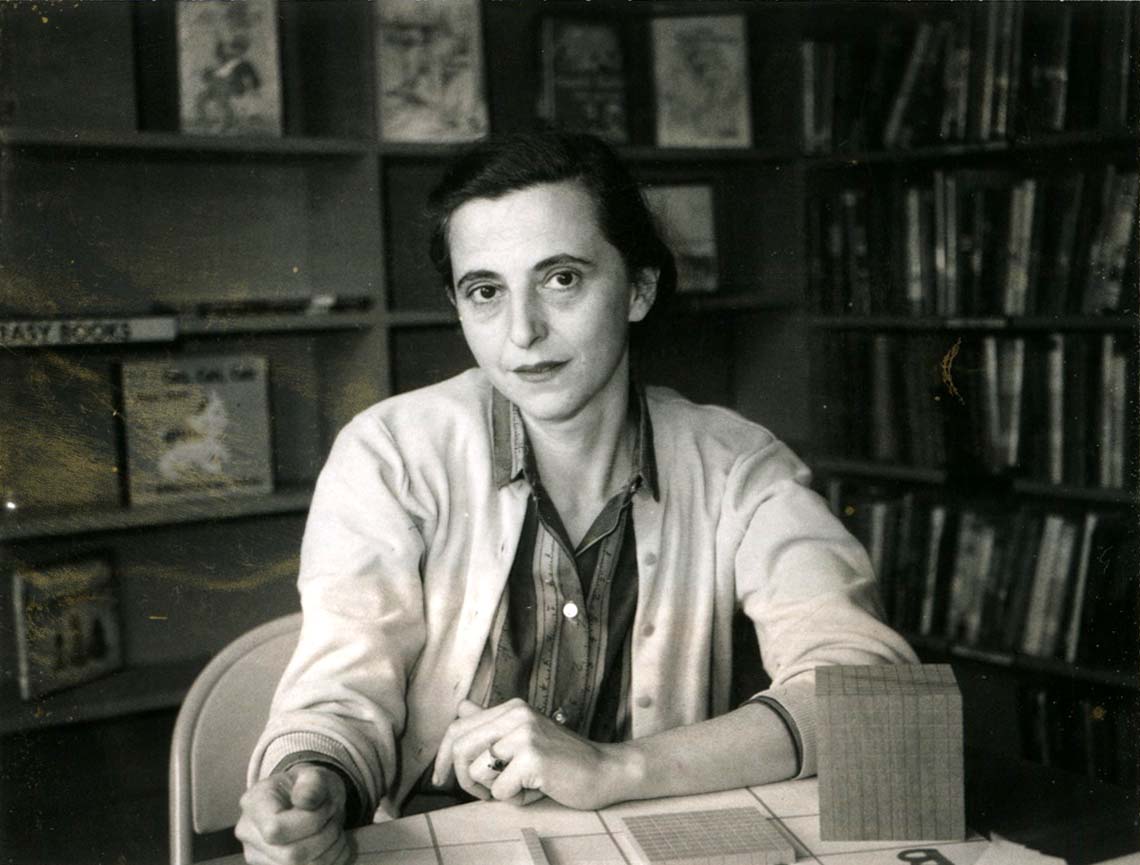
Lore at Miquon School in 1958.

Lore at Miquon School in 1958.
by Don
Lore was assigned to teach a group of third and fourth graders her first year at Miquon School. Unfortunately, she suffered from a period of depression and had to give up this responsibility and became a remedial mathematics teacher. When a child at Miquon had difficulty performing arithmetic problems that were expected of their grade level, they were sent down to the office building to be tutored by the remedial teacher. Although the phrase, “down to the remedial teacher,” referred to the location of the teacher’s office down the hill, it carried with it the connotation of being lower on the academic ladder.
I didn’t like this connotation; I reasoned that all the children at Miquon could benefit from tutoring in mathematics. I insisted that Lore work with a mixture of children, some of whom could do arithmetic very well along with some who had difficulty. No one was to be told he or she was there for remedial reasons.
Lore began by presenting mathematics problems to her little group of five or six pupils. All of the children found these problems challenging and interesting. One such problem involved drawing a group of six squares adjacent to one another in different ways, which, when the paper was folded, would make a cube. The entire school got involved with solving this problem as well as figuring out how many different shapes it was possible to make. It was interesting to watch who came up with the most patterns and how quickly the label “remedial” faded from use.
Lore’s classroom was small and bare, about ten feet square. There were no chairs; the children simply sat on the floor. There was also no chalkboard, so I got a sheet of Masonite, painted it, and cut it into small green squares to make each pupil an individual slate. Lore constructed hollow plastic models of the Platonic solids so the children could compare volumes using sand.
The children’s enthusiasm grew and they brought some of their problems home for their parents or siblings to work on. The little classroom became quite famous. Somehow news about it spread to the Institute for Advanced Study in Princeton. One day a professor at the Institute came and asked if he could observe the children working with Lore. It turned out he was one of the highest ranked topologists in the country. We gave him a small child’s chair to sit on, and once a week for several months he came to sit in the room and observe Lore with the children. We didn’t have much time to ask him about his reactions to the class. He just returned week after week.
Eventually, Lore’s program outgrew her little office, so we altered a porch on the office building to make a room that would hold a larger group of pupils as well as a chalkboard and other equipment. Lore’s accumulation of papers and equipment continued to grow. We began to get many requests from children in the school who wished to have more math classes. One day Dr. Albert Schatz and his wife came to visit Lore. They had two children in Lore’s class. The Schatzes gave Lore a hundred dollars to bring her materials and papers to a university that might be interested in them. Lore chose the University of Illinois, where considerable experimentation in the teaching of geometry was taking place under the direction of Dr. Max Beberman.
Arrangements were made for Lore to send a record of her work to Illinois. Soon Max came to Miquon, and we all became close friends. I remember Max coming to our home to work with Lore. They sat at a table all day and on into the evening. I don’t think they even took time to eat.
Lore’s program soon outgrew the larger room we had built on the office building. Publishers became interested in the possibility of publishing her books and papers for elementary schools, and we had a constant stream of visitors to her classes. In addition to visitors from the Philadelphia area, many came from all over the United States. Dr. Marshall Stone, head of the mathematics department of the University of Chicago, asked to visit Lore and stayed for three full days. Lore’s work gradually evolved into a mathematics laboratory for elementary school children, and she constantly added physical materials to her program.
Eventually we were given sufficient financial contributions to enable us to build a two-room building for a new laboratory. Lore began to invite classes of up to twenty children to her lab at one time. Each class was scheduled to attend the math lab almost every day. Lore took on a full-time assistant, Bob Hightower, a former Talladega student, so she could have some help.
Bob kept a diary of Lore’s meetings with the first graders. His notes were then published by SRA, titled First-Grade Diary. Lore made up hundreds of papers on different math topics. Children were free to choose the papers they wished to do. It was interesting to find that the papers they consistently chose to work on were the ones on which they scored 85% correct. This score was so consistent that their papers did not have to be corrected. If papers were too difficult or too easy, students did not choose to work on them.
One day, a reporter for Reader’s Digest came to ask if he could do a story about Lore’s work. We invited him in. He wrote a story entitled “She Turns Figures Into Fun” which was first published in PTA Magazine and later republished in the June 1961 edition of Reader’s Digest. The article was then published in twenty different languages and sold all over the world. In one year, we received two thousand letters from fifty different countries asking us how to teach mathematics to young children. It cost about a dollar and fifty cents to answer each letter and we didn’t have enough money or time to do so. Many years later, a representative of Reader’s Digest told me that the article about Lore’s math program was the most popular article they ever published.
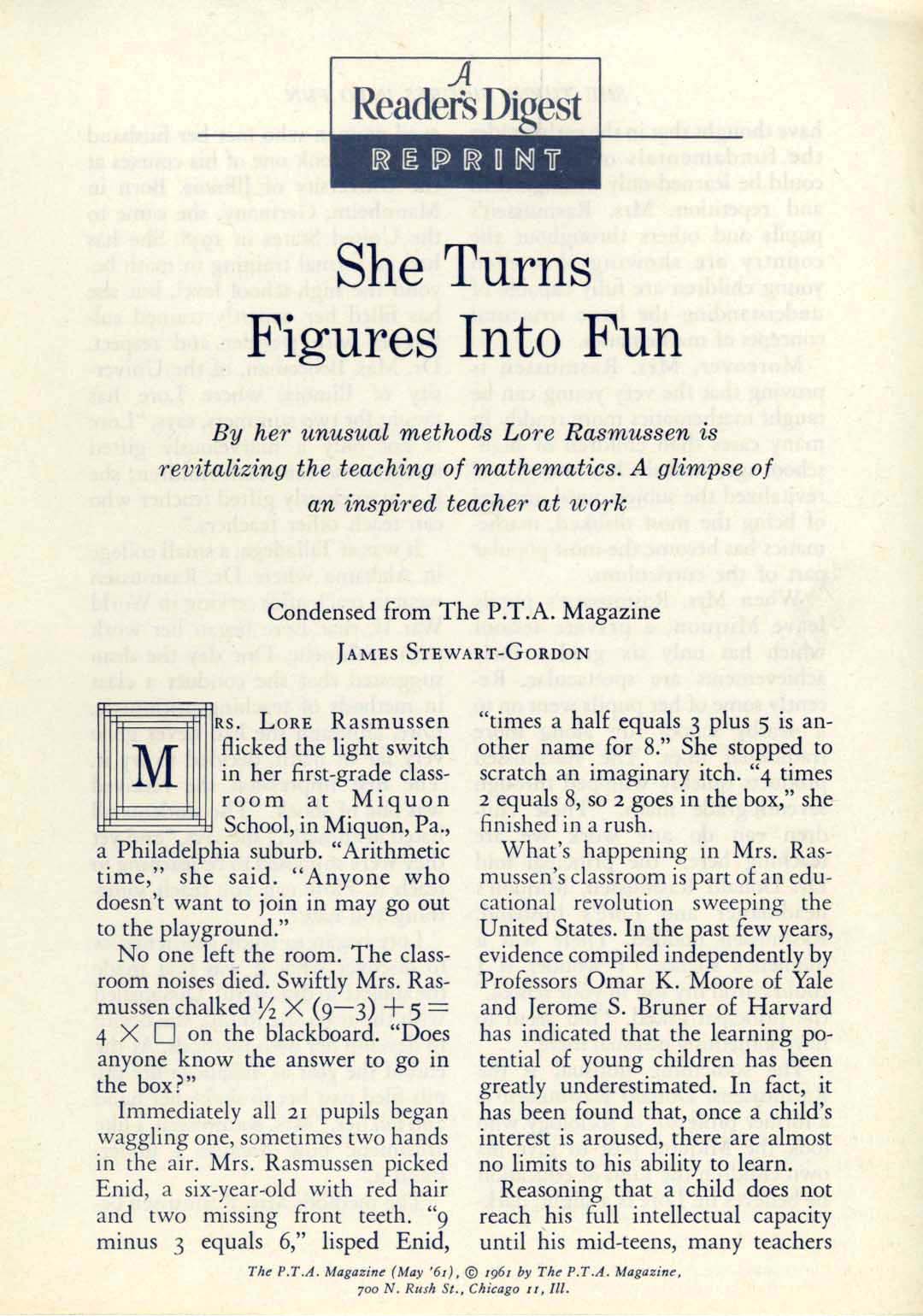
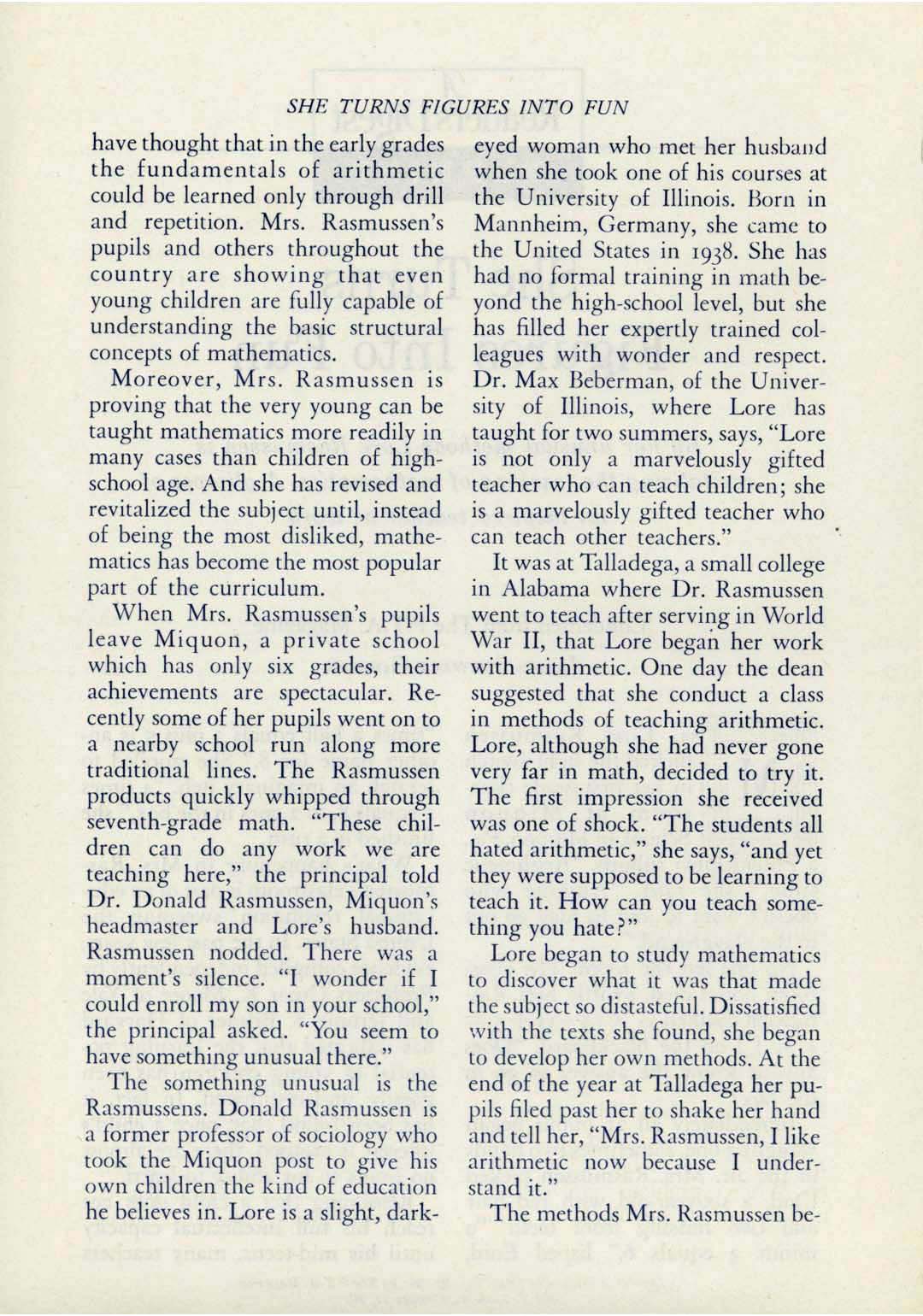
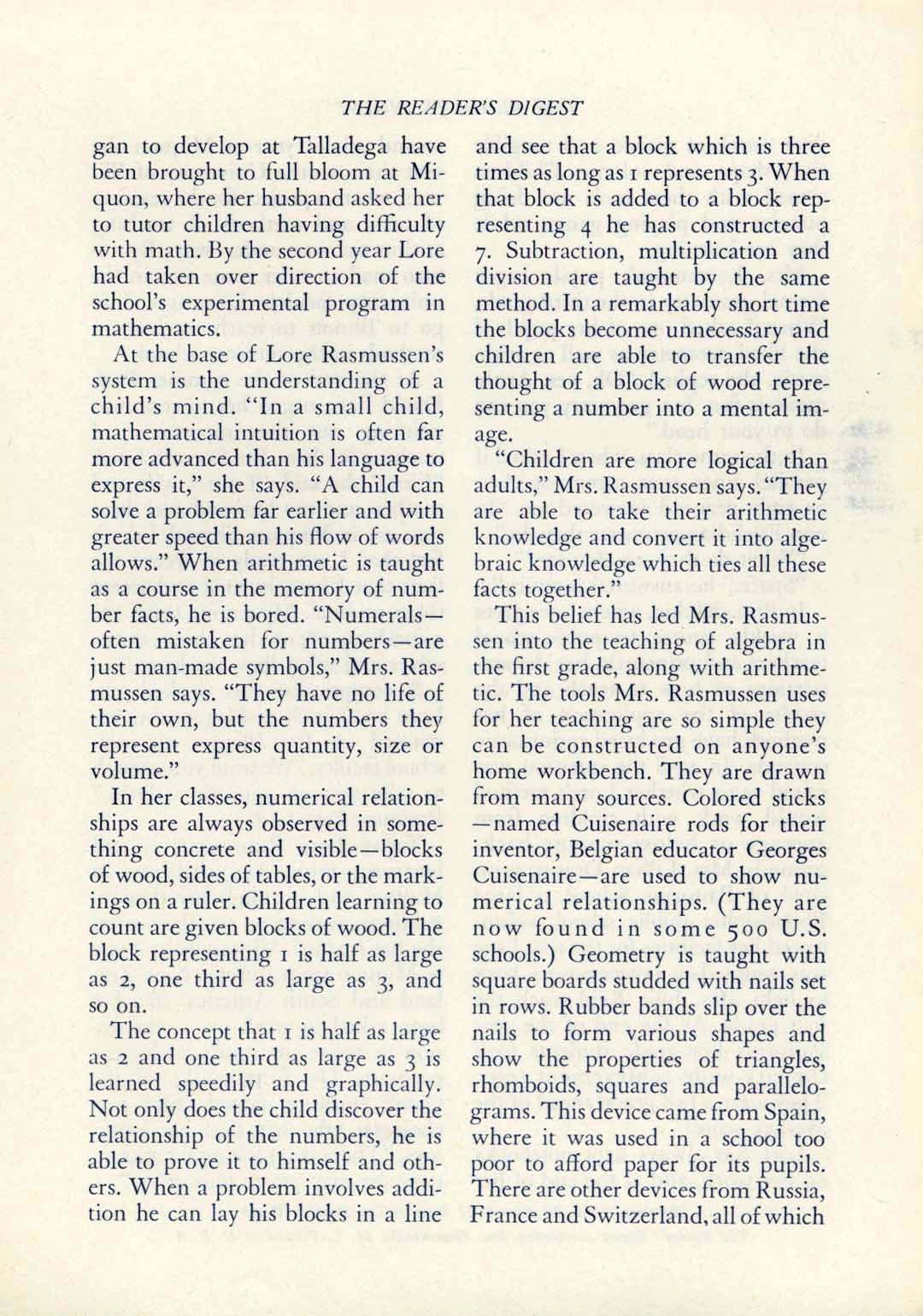
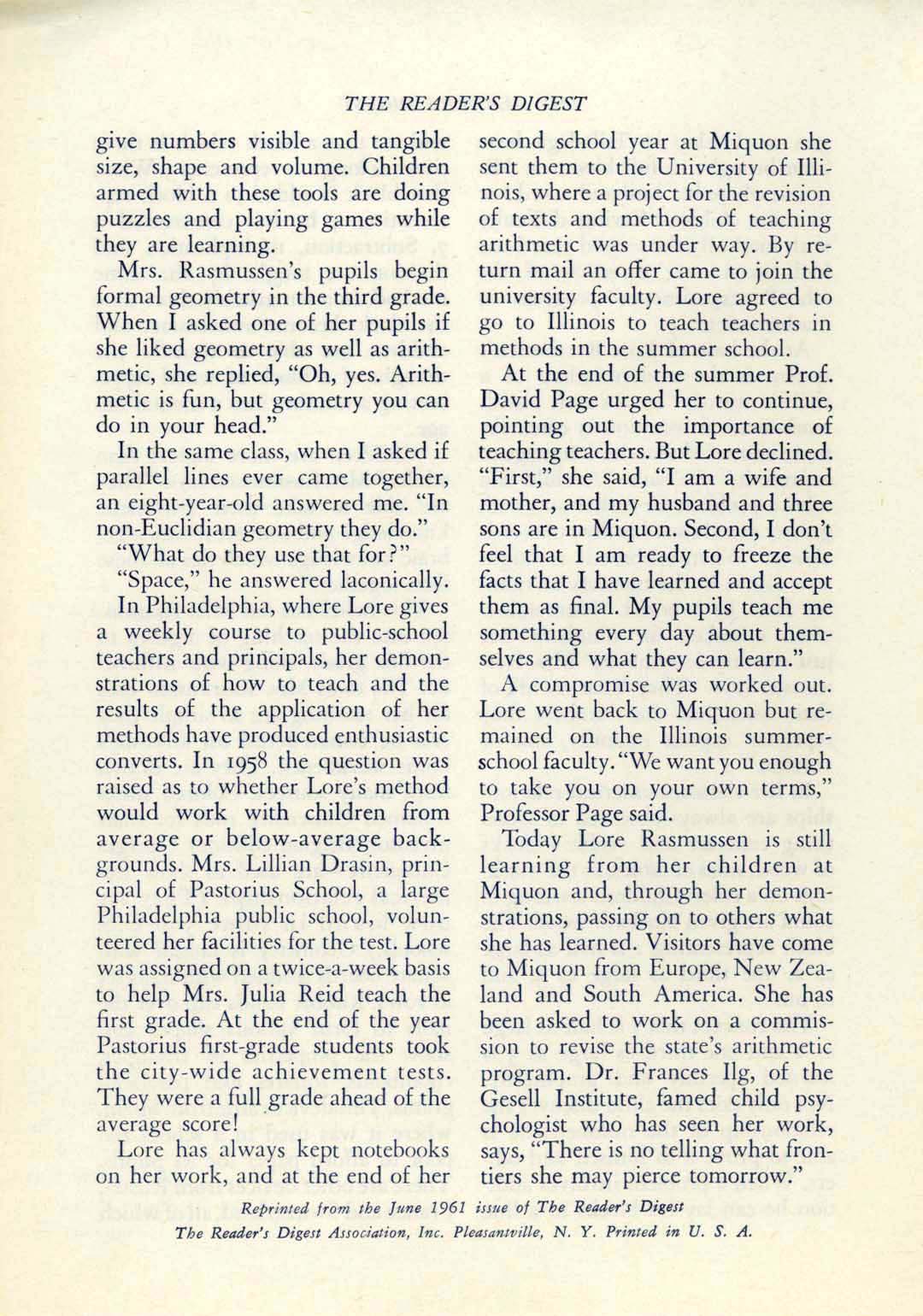
Lore’s main professional organization was the National Council of Teachers of Mathematics. She spoke to and gave demonstrations at regional and national conferences. She frequently gave demonstrations of her program on a stage before audiences of hundreds of teachers with a small group of students that she had never seen before. She would get the students so interested in solving mathematics problems they would forget completely that the audience was watching them. Many people were astounded at the way she could keep the attention of a class on a math topic.
Lore’s fame went abroad, especially to Puerto Rico, Costa Rica, and Mexico. In 1972, she was invited by Dr. Marshall Stone of the University of Chicago to address the Third Inter-American Conference on Mathematical Education in Bahia Blanca, Argentina. Lore’s address summarized her views on math in our society. There were many distinguished participants who had come from all over the Americas at that conference. The Argentinean mathematics societies were hospitable and eager to show us the best of their country. On our return to America, we stopped in Santiago, Chile, where Lore gave a workshop on elementary mathematics at the University of Chile before returning home.
Lore’s math lab program is still being published today, more than fifty years after she developed it.
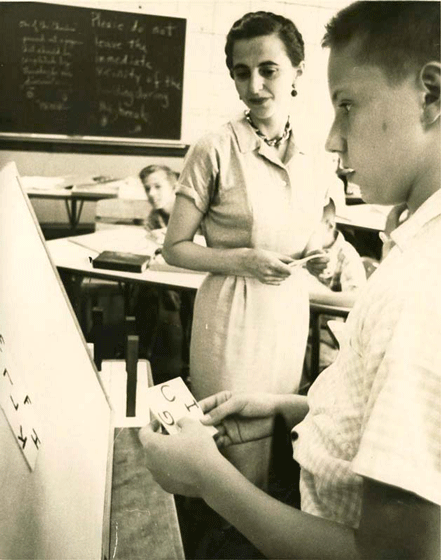
Lore with her students.
One evening in 1963, Lore and I were driving on Church Road north of Philadelphia. The radio in the car was on and we were listening to the news. There came an announcement that a bomb was set off in the Sixteenth Street Baptist Church in Birmingham, Alabama. Four young black Sunday school girls had been killed. Both of us were stunned, because we were very familiar with that church from our time in Alabama.
After the news of the Birmingham bombing, Lore and I were silent for some time. Lore spoke first. I will never forget her words. She said that she was now going to quit Miquon School and begin working in the worst of the slum areas of Philadelphia. In the next weeks she conceived of what she called her Learning Center Project, and she began to sell the idea to the Philadelphia Board of Education and to officials within the school system. She was successful in gaining support for the project, and she soon moved from Miquon to work in Philadelphia. I continued to work as principal at Miquon for one more year. Then I also moved to join Lore in the establishment of the first Teacher Center in the United States.
As we left Miquon, we were honored by the Commonwealth of Pennsylvania for our contribution to the public schools of the state. This was an unusual occurrence, because we were actually working at a small private school. But had made so many visits to public schools and had worked with so many of them that the state director of public education still cited us.
During her first year in the Philadelphia school system, Lore was able to establish her first Learning Center at the Frederick Douglass Elementary School in one of the most impoverished slums of the city. The principal, Mr. Thomas, welcomed Lore, as did members of the staff. The success of this first Learning Center enabled Lore to establish six more centers during the following year with programs similar to the one at Douglass.
About this time, Lore noticed that a new school for Center City children had just been completed, and the old school on South Street was left standing idle. Its condition was not dangerous, and Lore got the idea of establishing a special school to meet a number of needs of poor children in South Philadelphia. This institution became the Durham Child Development Center.
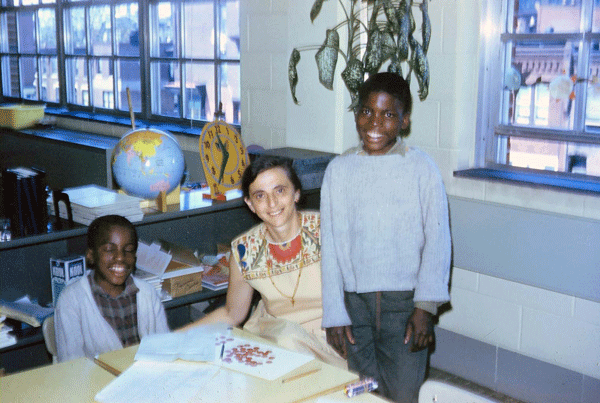
Lore with two of her Learning Center students.
by Maria Grasso Rincon
Read at Lore's Memorial Celebration at Miquon School, June 27, 2009
That’s how it happened to me forty-five years ago in Philadelphia. As a struggling, fledgling second-year classroom teacher, I was with a small reading group (five children in all) in front of the room, in a semi-circle at the chalkboard while 45 others were hopefully attending to written tasks at their desks. As luck would have it, the group I was with was that made up of the slower learners with many learning problems. Suddenly, footsteps were heard approaching my door; it was a good sign that I could hear them, indicating that the modest din of little voices was at a respectable level. My principal, Milt Goldberg, entered the room accompanied by a striking, tall, lofty and slender woman with gazelle-like eyes piercing my way. Our eyes met and we held each other’s glance for what seemed like a magic minute.
That august and awesome looking woman was Lore Rasmussen, who was soon to become my mentor, my teacher and inspiration.
As I shook myself back to reality and the task that waited at my knees, Lore left Mr. Goldberg at the classroom door and circled to the back of the room to the opposite side in a graceful fashion to where the ceiling-to-windowsill huge windows were aligned. She found a spot and stood there nodding her head approvingly and smiling. Because of her location, in front of the bright light of the windows, I could only make out her silhouette. Her beautiful dark eyes were no longer able to hypnotize me. With the illumination behind her, I went on with my teaching and a gentle peace overwhelmed me. Somehow intuitively I knew this was and would continue to be an auspicious event for me and my lifelong devotion to teaching.
The following day, Mr. Goldberg called me privately into his office and explained in detail who Lore was and that our school, the T. M. Peirce School, had been chosen to become part of a massive experiment in learning involving Lore and her innovative and ingenious methods of reaching children and inspiring them to learn. However, it was what he said next that showered me with pixie dust. He said that he and she wanted me to join her in this quest by being the on-sight teacher working with her daily and continuing the project whenever she wasn’t there. He said that a new facility would be constructed in the basement of the school equipped with wonderful learning tools specifically designed to upgrade math skills in the primary grades and that it would be called THE MATH LAB. All of this was music to my ears and I accepted the challenge with enthusiasm and optimism. Having set eyes on Lore the day before, I had no doubt that she and I were a match for this grand adventure with children.
After many months of work brainstorming together, Lore and I decided that the name we had given the project, The Math Lab, was limited and not comprehensive enough and that the more correct title or label, if you will, would be THE LANGUAGE LEARNING LAB, later shortened to The Learning Center.
During the next two years, Lore and I worked together in harmony as the children flowed into the Lab in small groups, magnetically gathering around Lore, who would be standing there greeting and intriguing them with a bag full of a variety of balls and a pan of water or an assortment of wooden, colorful sticks, called the Cuisenaire rods, and silly putty, which she used to adhere the rods to the chalkboard. She engaged the children with tactile elements while encouraging them to express themselves through her tactful questions, stimulating language, curiosity and discovery on the part of the children. As I watched her, observing her every move, taking quick notes and noting the children completely engaged and smitten by her every word and gesture, the lesson became symphony. During these months, I became one of her students while absorbing her skills as a master educator.
As time progressed, Lore and I, as colleagues in this new adventure were lifted to new heights; we were Don Quixote and Sancho Panza; we were the Alpha and Omega; we were the sun and the moon; the yin and the yang. Lore not only took me under her wing but into her heart; and it was there that we remained; she was my mother/teacher and I became her honorary daughter. For all of this I shall be eternally grateful for Lore. I love you Lore.
The rest is history, the experiment/project in learning took off as scheduled and what followed was magic preformed by Lore Rasmussen, master educator and innovator of learning with young children, teachers, student teachers and visitors. Lore and I, Milt Goldberg, and others from Temple University’s School of Education, and enlightened others from the Board of Education, and esteemed educators from around the country filled the remaining school year with a frenzy of magnificent learning experiences for young children.
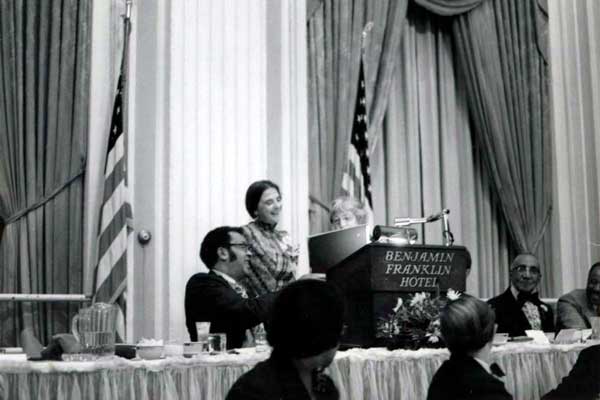
On March 22, 1976, Lore was honored by by the Citizens Committee on Public Education in Philadelphia
with the John B. Patterson Award for Excellence in Education.